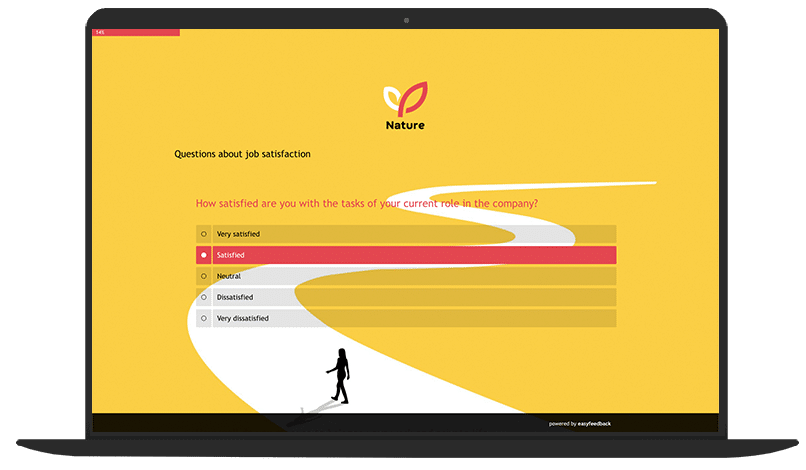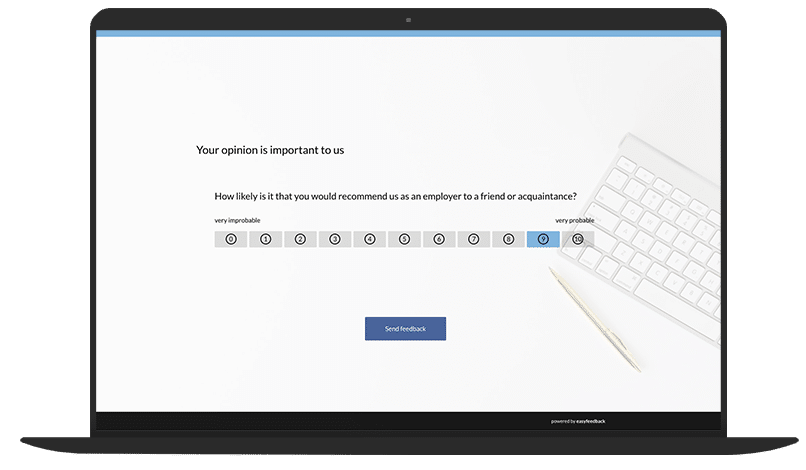Method 1: Employee surveys
One of the most effective and frequently used methods for measuring employee engagement is employee surveys.
By asking specific questions, companies can gain valuable insights into employee satisfaction, motivation and retention.
Such surveys can be conducted anonymously to obtain honest feedback.

Important topics in employee surveys:
- Satisfaction with the working environment
- Relationship with colleagues and superiors
- Opportunities for personal and professional development
- Perception of company values
- Work-life balance
In order to obtain meaningful results, the surveys should be conducted regularly – for example once a year, quarterly or once a month.
The results help to identify trends and initiate targeted measures to improve engagement.
Method 2: Employee appraisals
Another important tool for measuring employee engagement is regular employee appraisals.
In these one-to-one meetings, managers can directly address the needs and challenges of employees.

They allow an individual and in-depth look at the commitment and offer the opportunity to address specific problems or concerns.
These discussions should not be limited to assessing performance, but should also address personal well-being and satisfaction within the company.
Through open and honest communication, loyalty to the company can be strengthened and potential for improvement identified.
Method 3: Employee turnover rate and absenteeism analysis
Analyzing employee turnover and absenteeism provides valuable indirect indications of employee engagement.
High turnover rates or increasing absenteeism are often a sign that engagement in a company is declining.
If employees are dissatisfied or demotivated, this often manifests itself in frequent sick leave or the search for new career opportunities.
Companies should therefore regularly review these metrics and take targeted measures to understand and address the causes of dissatisfaction.
Method 4: Pulse surveys
Pulse surveys are a modern and quick method of measuring employee engagement in real time.
Unlike comprehensive annual surveys, pulse surveys are short, targeted surveys that are conducted at regular intervals – such as monthly or weekly.
They provide a “pulse” of the company and give immediate feedback on how employee engagement is developing.

The short surveys often focus on current topics, such as satisfaction with a new project or a recently introduced change in the company.
Pulse surveys are a flexible tool for reacting quickly to changes in employee engagement.
Method 5: Net Promoter Score (NPS) for employees
The Net Promoter Score (NPS), which is often used to measure customer satisfaction, can also be used to assess employee engagement.
A simple question like
“How likely is it that you would recommend our company as an employer?”
provides information on how strongly employees identify with the company.

Employees who would recommend the company to others are generally highly engaged and satisfied.
The eNPS is a straightforward method to get a quick overview of the general commitment of the workforce.
Method 6: Use of HR analytics
HR analytics is a data-driven approach to measuring employee engagement.
Various data points – such as performance, feedback, promotions, surveys and absenteeism – are linked and analyzed.
Algorithms can be used to identify patterns and trends that indicate decreasing or increasing engagement.
By combining various metrics, companies can obtain a comprehensive overview of engagement and intervene at an early stage if there is a need for action.
HR analytics provides a data-based foundation for strategic decisions to increase engagement.
Conclusion
Measuring employee engagement is crucial to understanding and specifically improving employee satisfaction and motivation.
Using methods such as employee surveys, employee appraisals, analyzing turnover rates and modern approaches such as pulse surveys or HR analytics, companies can gain valuable insights.
It is crucial that the data obtained is not only collected, but also translated into concrete measures to increase engagement.
This is the only way to build a committed, motivated and loyal workforce that contributes to the long-term success of the company.





